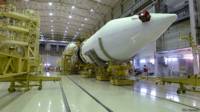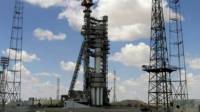- December 23, 2014
Post

In Russia, the first launch of a space launch vehicle heavy class “Angara”.
The missile was launched from the Plesetsk cosmodrome on Tuesday at 08:57 Moscow time. Branch-ton spacecraft layout from the upper stage occurred in 17:57.
Automation unit worked after the withdrawal of cargo on a geostationary orbit at an altitude of 36,000 kilometers.
In this first experimental launch ” Angara-A5 “can be considered successfully completed.
During the start-up in Moscow watched Russian President Vladimir Putin.
After the launching, he turned to the aerospace industry workers and those who participated in the preparation of the launch thanking them for their work.
The new heavy rocket
The lead developer and manufacturer of “Angara” is a Federal State Unitary Enterprise “State Research and Production Space Center of MV .Hrunicheva “.
The family of” Angara “includes different classes of media – from light to heavy load capacity from 1.5 to 35 tons.

In the future, “Angara” to replace heavy “Proton” that new heavy missile is superior to a number of indicators.
First, its payload of more than at the “Proton”.
However, this figure depends on the orbit and location of the spaceport, but in any case the maximum weight that “Proton” is able to deliver the reference orbit – 27 tons to 35 tons at “Angara “.
” Angara “against” Proton “
Secondly, it is much less dangerous for the environment. “Angara” uses kerosene as fuel and oxidant oxygen acts.
“Proton” is used as a propellant mixture heptyl (dimethylhydrazine) and oxidant – amyl (dinitrogen tetroxide).

Both substances are highly toxic and in case of an accident heavily pollute the soil, requiring the decontamination.
As the merits of a new missile is also referred to the fact that its completely designed and built in Russia in Russian enterprises.
However, as told RIA Novosti Russian Academy of Cosmonautics Tsiolkovsky Alexander Zheleznyakov, actually until abandon foreign electronics will not work.
“Despite the fact that in the” Angara “there are still elements of the non-Russian production, it will not affect the mission” Angara “. A completely replace foreign components can be no earlier than three years, as indicated in the program of import substitution” – Zhelezniakov told RIA Novosti.
Space “designer”
The rocket is going on a modular principle that, on the one hand, simplifies the task of sending it from the factory to cosmodrome, on the other – allows you to “collect” the carrier based on the needs of the specific program.
The rocket is assembled from universal rocket modules – URM-1 and URM-2, the first and second stages, respectively.
URM-1 in the case of a missile launched by December 23 are docked to it on the sides of four booster module.
URM-2 – the main, central part of the rocket. The third stage is not provided, however, as in the case of test start, “Angara” can output the reference orbit upper stage “Breeze-M”, which is in fact the third stage.
No comments:
Post a Comment